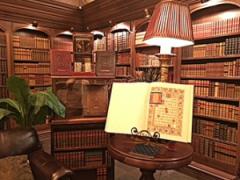"Banned, Burned, Seized, and Censored" Exhibition at the Ransom Center
AUSTIN, Texas—"Banned, Burned, Seized, and Censored," an exhibition at the Harry Ransom Center, reveals the rarely seen "machinery" of censorship in the United States between the two world wars.
The exhibition runs from Sept. 6 to Jan. 22, 2012, at the Ransom Center, a humanities research library and museum at The University of Texas at Austin.
Featuring more than 200 items drawn primarily from the Ransom Center's collections, the exhibition explores the question: How did hundreds of thousands of books, pictures, plays and magazines come to be banned, burned, seized and censored in less than 30 years?
"Traditionally, censorship exhibitions start with John Milton's 'Areopagitica' and then provide a list of banned books," said Ransom Center Assistant Director and Curator for Academic Programs Danielle Sigler. "This approach gives you perspective on which books have been banned over time, but it doesn't explain why or how censorship took place. This exhibition focuses on how censorship happens in one country, during a particular era. The New York Society for the Suppression of Vice had a leader who stormed into bookshops, pulled things off the shelves and hauled people to court. The New England Watch and Ward Society in Boston created an informal network of booksellers who quietly removed books from the shelves when they were deemed obscene. At the same time individuals operating as postmasters and customs agents decided for themselves what was obscene."
The exhibition draws heavily from the Ransom Center's collection of Morris Ernst, the leading civil liberties attorney who successfully defended James Joyce's "Ulysses" when it was put on trial for obscenity in 1933. In 2009, the Ransom Center received a grant from the National Endowment for the Humanities to catalog the Morris Ernst papers. The Ernst papers will be open for research in late 2011. The exhibition features correspondence revealing the mechanics behind censorship, manuscripts edited for obscenity and pirated editions of James Joyce's "Ulysses" and D. H. Lawrence's "Lady Chatterley's Lover."
"Because the Center houses collections from writers, agents, publishers and attorneys, we can tell all aspects of this story," said Sigler.
The exhibition is organized by censoring institution, including sections on the New York Society for the Suppression of Vice, the New England Watch and Ward Society, the Book-of-the Month Club, the Post Office Department and the Treasury Department, as well as sections on the 1933 "Ulysses" trial and writers' responses to censorship.
Between the two world wars, censors waged war on "objectionable" literature using tactics from extra-legal intimidation to federal prosecution. Larger-than-life personalities battled publicly over obscenity, "clean books" and freedom of expression while writers, agents and publishers attempted to navigate the increasingly complex world of American censorship.
"The exhibition is limited to a particular time period, so the visitor can begin to get a sense of the materials that reformers deemed objectionable at that specific moment in American history," said Sigler. "During the interwar years, more often than not, the objection boiled down to sex.
"One of the goals of the exhibition is to show that censorship is far more complicated than one might think. In the United States in this particular period, it was not a matter of a monolithic body censoring books. The process is more nuanced. As you look at these materials, you begin to understand why reformers argued for censorship, why authors battled against it and even why some publishers found censorship a boon for sales."
High-resolution press images from the exhibition are available.
"Banned, Burned, Seized, and Censored" can be seen in the Ransom Center Galleries on Tuesdays through Fridays from 10 a.m. to 5 p.m., with extended Thursday hours to 7 p.m. On Saturdays and Sundays the galleries are open from noon to 5 p.m. The galleries are closed on Mondays.
The exhibition runs from Sept. 6 to Jan. 22, 2012, at the Ransom Center, a humanities research library and museum at The University of Texas at Austin.
Featuring more than 200 items drawn primarily from the Ransom Center's collections, the exhibition explores the question: How did hundreds of thousands of books, pictures, plays and magazines come to be banned, burned, seized and censored in less than 30 years?
"Traditionally, censorship exhibitions start with John Milton's 'Areopagitica' and then provide a list of banned books," said Ransom Center Assistant Director and Curator for Academic Programs Danielle Sigler. "This approach gives you perspective on which books have been banned over time, but it doesn't explain why or how censorship took place. This exhibition focuses on how censorship happens in one country, during a particular era. The New York Society for the Suppression of Vice had a leader who stormed into bookshops, pulled things off the shelves and hauled people to court. The New England Watch and Ward Society in Boston created an informal network of booksellers who quietly removed books from the shelves when they were deemed obscene. At the same time individuals operating as postmasters and customs agents decided for themselves what was obscene."
The exhibition draws heavily from the Ransom Center's collection of Morris Ernst, the leading civil liberties attorney who successfully defended James Joyce's "Ulysses" when it was put on trial for obscenity in 1933. In 2009, the Ransom Center received a grant from the National Endowment for the Humanities to catalog the Morris Ernst papers. The Ernst papers will be open for research in late 2011. The exhibition features correspondence revealing the mechanics behind censorship, manuscripts edited for obscenity and pirated editions of James Joyce's "Ulysses" and D. H. Lawrence's "Lady Chatterley's Lover."
"Because the Center houses collections from writers, agents, publishers and attorneys, we can tell all aspects of this story," said Sigler.
The exhibition is organized by censoring institution, including sections on the New York Society for the Suppression of Vice, the New England Watch and Ward Society, the Book-of-the Month Club, the Post Office Department and the Treasury Department, as well as sections on the 1933 "Ulysses" trial and writers' responses to censorship.
Between the two world wars, censors waged war on "objectionable" literature using tactics from extra-legal intimidation to federal prosecution. Larger-than-life personalities battled publicly over obscenity, "clean books" and freedom of expression while writers, agents and publishers attempted to navigate the increasingly complex world of American censorship.
"The exhibition is limited to a particular time period, so the visitor can begin to get a sense of the materials that reformers deemed objectionable at that specific moment in American history," said Sigler. "During the interwar years, more often than not, the objection boiled down to sex.
"One of the goals of the exhibition is to show that censorship is far more complicated than one might think. In the United States in this particular period, it was not a matter of a monolithic body censoring books. The process is more nuanced. As you look at these materials, you begin to understand why reformers argued for censorship, why authors battled against it and even why some publishers found censorship a boon for sales."
High-resolution press images from the exhibition are available.
"Banned, Burned, Seized, and Censored" can be seen in the Ransom Center Galleries on Tuesdays through Fridays from 10 a.m. to 5 p.m., with extended Thursday hours to 7 p.m. On Saturdays and Sundays the galleries are open from noon to 5 p.m. The galleries are closed on Mondays.


















